Morimoto 2Stroke 2.0 vs. SuperNova V.4 LED Lights
As of recently, LED conversion kits have started getting closer and closer to the performance and light pattern of a typical oem HID or aftermarket HID conversion kit. If a car has factory HID headlights, there’s no gain of switching to LED other than longevity. Most use cases for LED conversion kits are for those running factory halogen headlights. With these newer generation LED kits, the LED’s are starting to mimick the output of a halogen bulb closer than they ever have before. This means it will produce the correct light pattern and hotspots that are necessary.
This review will cover the Morimoto 2Stroke 2.0 LED kit against the SuperNova V.4 LED kit.

Morimoto 2Stroke 2.0
The Morimoto 2Stroke 2.0 LED conversion kit came to market in late 2018. These are a replacement to their previous generation 2Stroke LED kit. The new 2Stroke 2.0’s are a smaller form factor to fit almost every application with ease, along with improved light output and better reproduction of halogen bulbs due to the design of the copper board and the new Philip’s Z ES chips.
Pricing
The Morimoto 2Stroke 2.0 can be purchased directly from the morimoto website for $145, but can be found at other reputable vendors for $120. I will talk more below about where to buy these along with the SuperNova headlights later in this post.
Specs
The new generation 2Stroke 2.0’s have some pretty good specs as shown below:
| Lumen Per Bulb | Kelvin (color) | Input Power Per Bulb | Draw |
|---|---|---|---|
| 2440lm | 5700k | 23w | 1.9A 12V DC |
Warranty
The Morimoto 2Stroke 2.0’s come with a 3 year manufacturer warranty.
SuperNova V.4
The SuperNova V.4 LED conversion kit came to market in late 2018 as well. These are a replacement to their previous generation SuperNova V.3 kit which was very popular. The new V.4 moved from a flexible heat sink design to a standard CNC machined aluminum heat sink with a fan to assist cooling. The new V.4’s also use the newest CREE NLW1860CV2 chips, which allow one continuous diode without gaps between them like the Morimoto. This results in a better light pattern that’s very similar to a halogen bulb.
Pricing
The SuperNova V.4 LED kit can be purchased for $159-$169, depending on the type of kit you need for your application. I will discuss where to buy later in this post.
Specs
The new generation SuperNova V.4 have some pretty insane specs as shown below:
| Lumen Per Bulb | Kelvin (color) | Input Power Per Bulb | Draw |
|---|---|---|---|
| 3600lm | 6000k | 36w | 2.5A 14V DC |
Warranty
The SuperNova V.4’s come with a 2 year manufacturer warranty.
Comparison
I know this is the part everyone wants to see. How do these things compare? Which one should I buy? What differences in pricing are there? I will go into depth below as well as pictures for your viewing pleasure.
Size and Design
It’s important to understand the differences between these two kits as far as size goes. The 2Stroke 2.0’s are tiny in comparison to the SuperNova V4’s, both in the driver and the heatsink. The larger the heatsink and driver, the harder it will be to fit these nicely inside of a headlight housing.
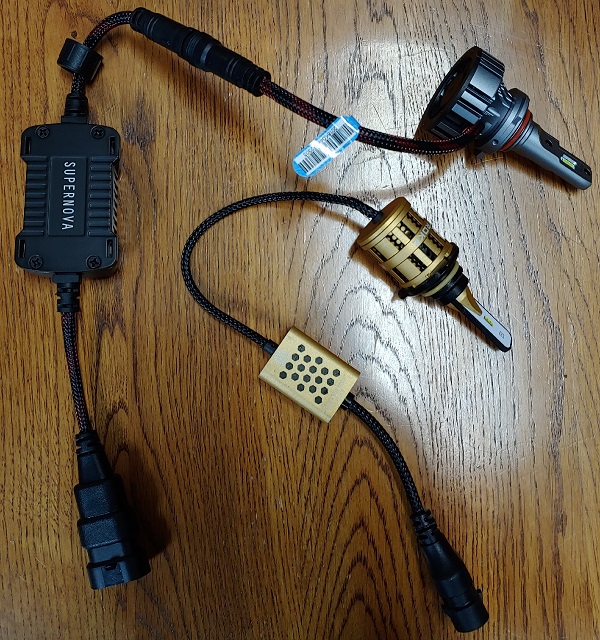
As you can see above, the Morimoto has a much smaller driver, which I can attest makes installation and fit an absolute breeze compared the larger driver of the SuperNova’s. The heatsink design is also more compact on the Morimoto, with an internal fan versus the SuperNova’s external fan.
Below, you’ll see a much closer side-by-side comparison, showcasing some of the differences between the LED’s on the board, as well as the heatsink designs.

The SuperNova utilizes a new CREE chip that utilizes one continuous diode compared to the Morimoto design incorporating three individual Philips Z ES chips.
Color
These two are extremely similar as far as color goes. The SuperNova’s 6000k Kelvin rating results in them having a slightly more cool blue tint than the Morimoto’s 5700k Kelvin rating. One thing I found interesting is the Morimoto box advertises the 2Stroke 2.0 as 5500k, but the website says 5700k. Either way, the difference is mostly negligible, with the SuperNova’s having ever so slightly more of a cool blue tint. Subjectively, I noticed an ever so slight difference between the two. In the section below, you’ll see a side-by-side against a garage door, and can notice a difference in color.
Noise
You might be wondering why there’s a noise category. In order to drive LED’s to the intensity needed for headlights, they tend to generate some heat. Each light has a heatsink to help with this heat management, but that’s not enough. Each use a fan to aid in cooling, which generate some noise. The Morimoto 2Stroke 2.0’s are very loud, and I’ve had people constantly ask “what’s that noise” when my headlights are on. You don’t hear them from inside the car, but if you get out and the lights are on, they’re definitely noticable. The SuperNova’s on the other hand are almost silent. I really appreciate that coming from the Morimoto’s. You can just barely hear the fans humming, but nothing anyone would notice unless I told them.
Light Output
In order to be able to measure light output instead of a subjective measurement, I used a digital Lux meter to capture the Lux measurement at 25 feet.
Lux is a measurement of lumens in a square meter. In essence, it’s a measurement of the amount of visible light present. As you shine your headlights at a wall and slowly back away, the light is distributed over a greater area. This results in any given square meter having less lumens or “brightness”. What matters most when comparing LUX between 2 different bulbs is that they’re measured at the same distance and same housing. The photo below shows how the LUX measurement process works.
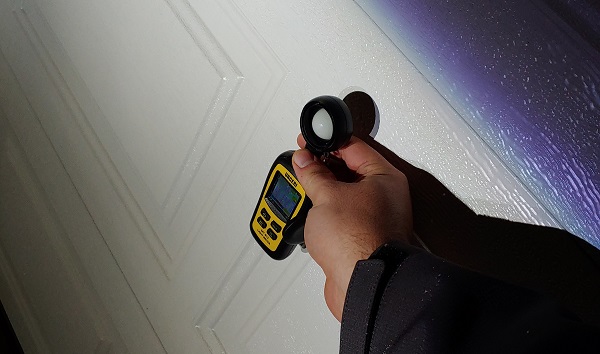
Below is the maximum Lux measurement I was able to get from each LED kit in my 2015 Ford Explorer Sport Projector headlights at 25 feet. The left side is the Morimoto 2Stroke 2.0, and the right is the SuperNova V.4’s.
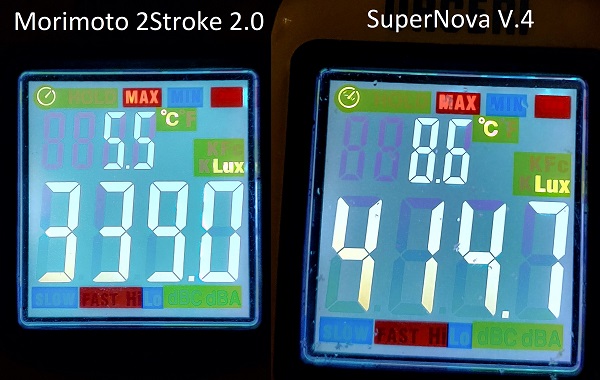
As you can see, the SuperNova measured a maximum Lux of 414.7 as compared to the Morimoto’s maximum Lux of 339. This means the SuperNova V.4’s are roughly 22% brighter than the Morimoto’s in my testing. Please note that results do vary, and there’s a lot of factors going into this measurement such as housing type, bulb type, Lux measurement tool, and more.
Light pattern is also extremely important with LED headlights. If the diode’s don’t accurately represent the original halogen bulb, you aren’t going to have the correct hotspots and pattern necessary, and may blind incoming drivers. Below is an example side-by-side of the light pattern of the Morimoto’s and the SuperNova’s in my Explorer’s projector headlights. I apoligize for not centering myself better in my driveway for the Morimoto picture as compared to the SuperNova’s. Also, keep in mind my driveway has a steep incline, so the light might seem high, but it’s just the angle I’m sitting. These shots are taken from exactly 25 feet away.
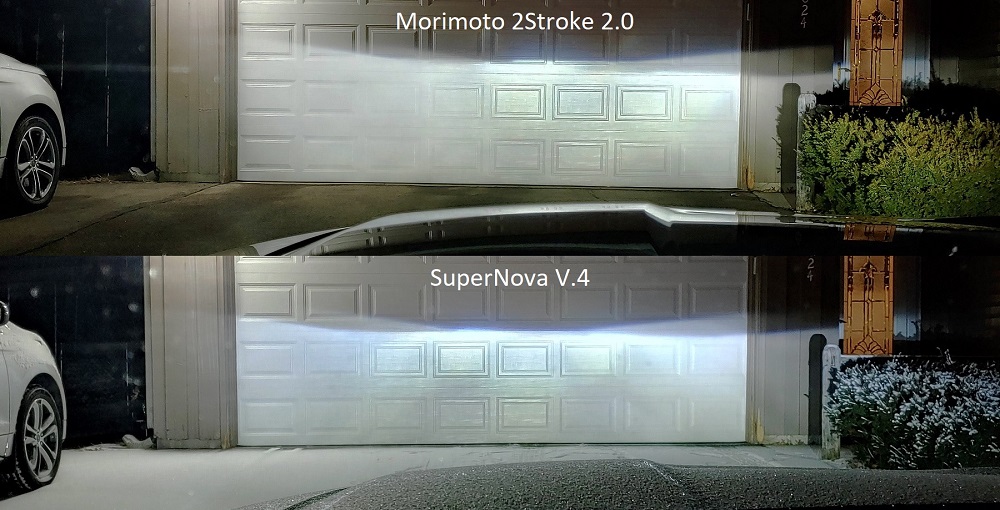
As you can see above, the light patterns, intensity, and hot spots are a bit different. The SuperNova has a much cleaner pattern, with more defined hotspots to help see further down the road. The Morimoto’s have a pretty good pattern as well, but don’t do as good of a job as the SuperNova’s as far as creating those important hotspots. I’m not a light expert, but the SuperNova’s do a very good job reproducing the original halogen light pattern.
I did not capture any night shots of the Morimoto’s (sorry), but I have a couple examples of the SuperNova’s below. I’ve been using the Morimoto 2Stroke 2.0’s now for about 3 months, and will update this post when I get more driving time with the SuperNova’s.
Here are the SuperNova’s in my Explorer’s projector headlights on low (sorry for the blur). Once I’m able to get better pictures of the light output, I will update this post.
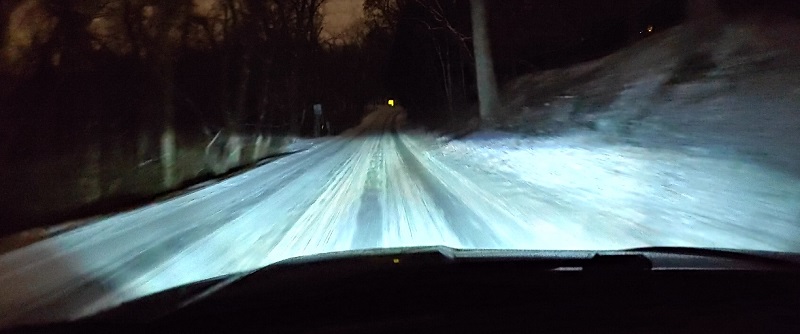
Here are the SuperNova’s in my Explorer’s projector headlights on high beams.

Where To Buy
I definitely recommend checking out both The Retrofit Source and Headlight Revolution for your lighting needs. The Retrofit Source has the Morimoto’s for $120 but do not sell the SuperNova’s. Headlight Revolution has both the Morimoto’s and SuperNova’s on their website.
I actually had an issue with one of my SuperNova V.4’s, and Headlight Revolution was great to work with and sent me a replacement ASAP without me requiring to ship back the old one (due to their field destroy program). I also have to root for Headlight Revolution as they’re a Minnesota company and I live in Minnesota. They also have done an insane amount of LED testing, and have tons of helpful YouTube videos on them that I definitely recommend checking out. This video is long, but worth watching if you’re new to LED headlights.
Final Thoughts
Overall, both options are good alternatives to halogen bulbs. LED’s last an extremely long time, use less power, and have a much more attractive color. I think they still have a little bit to go to be a perfect replacement to HID’s, but given a couple of more years I’m sure they’ll get there.
Between the two, I would lean towards the SuperNova V.4’s due to the brigher light output, better pattern, and quieter fan. My only wish for the SuperNova’s is a smaller driver similar to that of the Morimoto’s.
Thanks for reading, and feel free to comment below with any questions. I’d be glad to assist if I can!

Comments